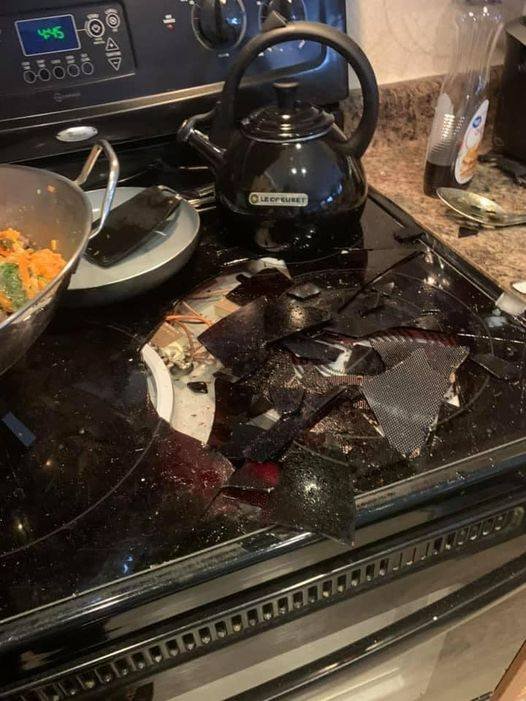Glass stovetops are a modern and stylish addition to many kitchens, offering a smooth surface that’s easy to clean and aesthetically pleasing. However, these sleek appliances require careful handling to prevent damage and maintain their functionality. Neglecting proper care or adopting unsafe habits can lead to scratches, cracks, and even hazardous situations. To keep your glass stovetop in excellent condition, it’s important to avoid certain mistakes that could compromise its performance or longevity.

One of the most common mistakes is using rough or abrasive cleaners on a glass stovetop. While these products may seem effective for tough stains, they can cause significant damage by scratching the surface. These scratches not only dull the appearance of the stovetop but can also weaken its structure over time. Instead, always use gentle cleaning solutions specifically designed for glass stovetops, paired with a soft microfiber cloth or sponge to safely clean without causing harm.
Another dangerous habit is placing heavy pots and pans on the stovetop. While glass stovetops are built to handle standard cookware, excessively heavy items like cast iron pots or oversized stockpots can create pressure points that may lead to cracking or shattering. It’s essential to use lightweight cookware whenever possible and handle heavy items with extra caution. If you need to use heavier pots, make sure to place them gently on the stovetop to avoid unnecessary stress on the glass.
Sliding pots and pans across the surface is another practice to steer clear of. Dragging cookware can leave scratches that not only mar the stovetop’s appearance but also affect its efficiency over time. These scratches can create uneven heating areas, leading to less effective cooking. Always lift pots and pans when moving them from one burner to another to prevent unnecessary damage to the glass surface.
Leaving spills and stains on the stovetop might seem harmless in the moment, but over time, they can become baked onto the surface. This buildup not only makes cleaning more challenging but can also cause discoloration and weaken the stovetop. To avoid this, clean spills promptly after cooking. A quick wipe with a damp cloth or a gentle stovetop-safe cleaner is often enough to prevent stubborn stains from forming.
Cooking with dirty cookware is another habit to avoid. Residue or grease on the bottom of pots and pans can transfer to the stovetop, leading to scratches or burned-on marks. Always ensure that your cookware is clean before placing it on the glass surface. This simple step not only protects the stovetop but also promotes more efficient and even cooking.
Placing hot lids face down on the stovetop is another mistake that can cause serious damage. Hot lids, particularly those made of glass, can create sudden temperature changes when placed on the cooler stovetop surface. This thermal shock can lead to cracks or even shattering. To prevent this, always place hot lids on a heat-resistant surface like a trivet or pot holder instead of directly on the stovetop.
Ignoring small cracks or chips on your glass stovetop is a risky habit that can have serious consequences. Even minor damage can expand under heat and pressure, potentially causing the entire surface to shatter. If you notice any cracks or chips, it’s crucial to address them immediately by consulting a professional repair service. Timely repairs can prevent further damage and maintain the safety of your appliance.
Heating an empty pot or pan is another habit to avoid. Empty cookware can overheat quickly, potentially damaging both the stovetop and the cookware itself. Overheating can leave permanent marks or cause the glass to warp or crack. To avoid this, always ensure there is food or liquid in the cookware before turning on the heat.
Using the wrong cookware is also a common issue. Cookware with warped or uneven bottoms can cause uneven heating, leading to hot spots that may damage the stovetop. Heavy materials like cast iron or stoneware are more likely to scratch or crack the glass. Stick to cookware with flat, smooth bottoms, such as stainless steel or anodized aluminum, to protect the surface and ensure even cooking.
Finally, not following the manufacturer’s instructions is a mistake that many people make. Each glass stovetop comes with specific care and usage guidelines, and neglecting these recommendations can lead to avoidable damage or void the warranty. Take the time to read the user manual and follow the instructions for cleaning, maintenance, and cookware selection. By adhering to these guidelines, you’ll extend the life of your stovetop and avoid unnecessary risks.
In summary, while glass stovetops are a beautiful and functional feature in modern kitchens, they require mindful care and attention. Avoiding these ten dangerous habits can prevent scratches, cracks, and other forms of damage, ensuring that your stovetop remains in pristine condition for years to come. Treat your glass stovetop with care, clean it regularly using the right products, and handle cookware responsibly to enjoy a safe and efficient cooking experience.





